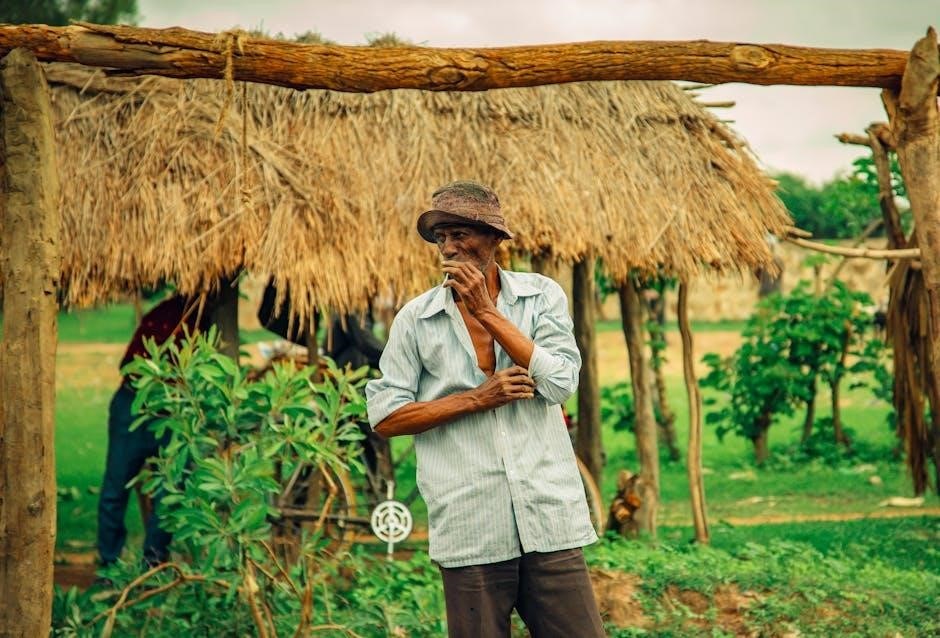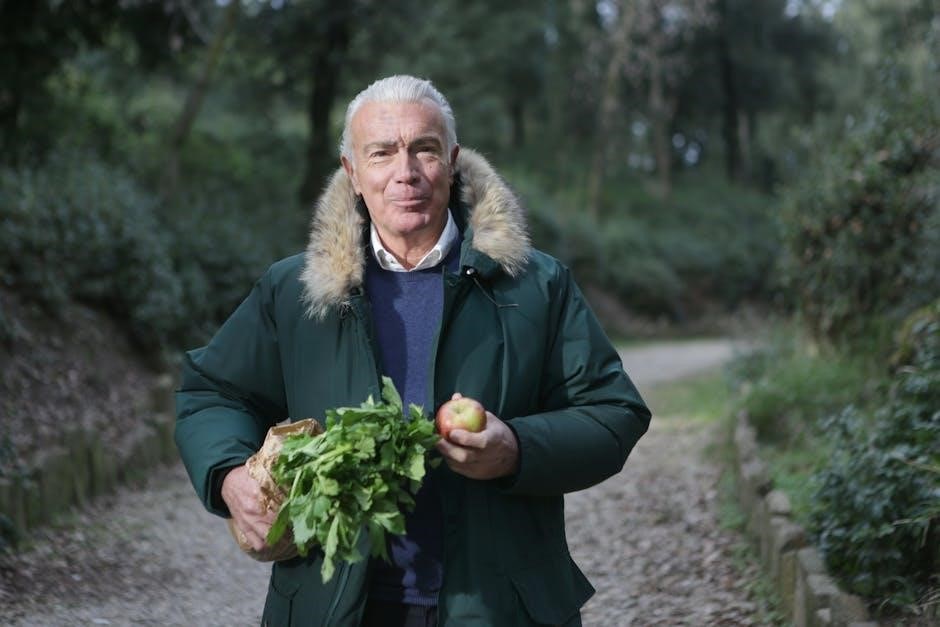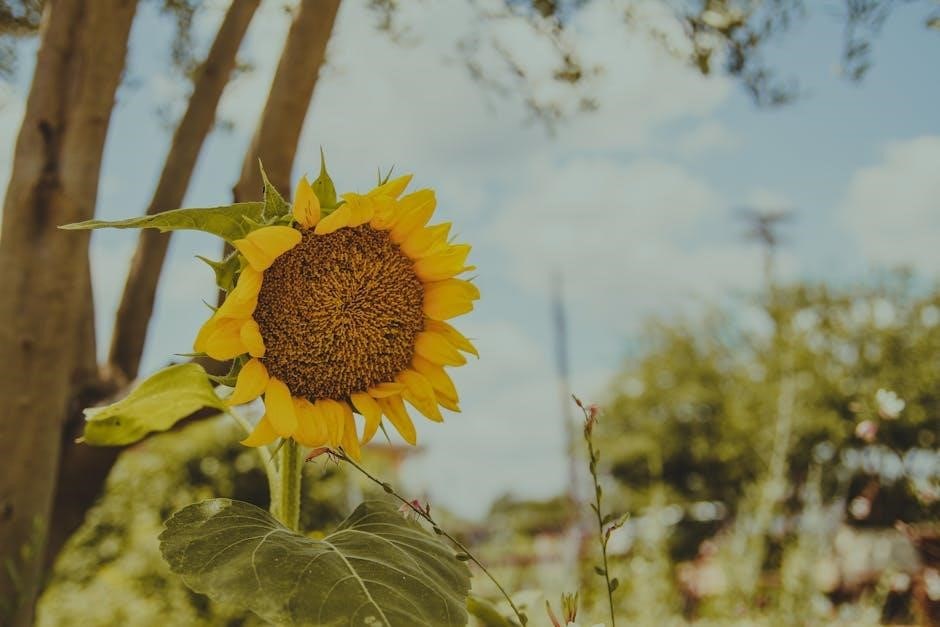The East Texas Planting Guide 2024 offers expert advice on optimal planting times, soil preparation, and seasonal gardening tips, helping gardeners thrive in the region.
1.1 Understanding the Planting Zones in East Texas
East Texas is divided into specific planting zones that guide gardeners on optimal growing conditions. Average last spring frost dates and first fall frost dates vary, with zones influenced by microclimates. Understanding these zones helps gardeners select plants suited to their area, ensuring better growth and yields. This knowledge is crucial for timing plantings accurately and maximizing the growing season in East Texas.
1.2 Importance of Seasonal Planting in East Texas
Seasonal planting is vital in East Texas due to its varied climate and soil conditions. Aligning plantings with local frost dates and microclimates ensures optimal growth and productivity. By following seasonal guidelines, gardeners can avoid crop damage from extreme temperatures and moisture fluctuations, leading to healthier plants and higher yields. This approach also supports biodiversity and sustainable gardening practices throughout the year in the region.

Optimal Planting Times for Vegetables in East Texas
Plant vegetables in spring (February-May) and fall (August-October) for best results in East Texas, considering average frost dates and microclimate variations for higher yields and success.
2.1 Spring Planting Dates for Popular Vegetables

Broccoli, beets, and carrots thrive when planted in February-March, while tomatoes and peppers do best in late March-early April. Start seeds indoors 4-6 weeks before transplanting. Ensure soil is workable and avoid planting too early to prevent frost damage. The average last spring frost date in East Texas is around March 15th, so plan accordingly for optimal growth and yield.
2.2 Fall Planting Dates for Vegetable Gardens
Fall planting in East Texas begins in late summer to early fall, with crops like beans, Lima beans, and beets planted by August 1st. Broccoli and spinach thrive when seeded in late August to early September. Plant cool-season crops 8 weeks before the first fall frost, which averages November 15th. Ensure proper soil preparation and spacing for optimal growth during the cooler months.
- Beans: August 1st
- Beets: August 1st
- Broccoli: August 15th
- Spinach: September 1st
Best Vegetables to Grow in East Texas
Tomatoes, peppers, cucumbers, squash, beans, and okra thrive in East Texas’s warm, humid climate, making them ideal choices for successful gardening in the region.
3.1 Recommended Varieties for Spring Gardens
For spring gardens in East Texas, consider planting tomatoes (Better Boy, Early Girl), peppers (Bell Boy, Jalapeño), cucumbers (Slicing, Pickling), squash (Yellow Crookneck), and green beans (Bush Blue Lake). These varieties thrive in the region’s warm, humid climate and acidic soils. Leafy greens like spinach and lettuce also excel in cooler spring weather. Plant seeds or seedlings in late February to early March for optimal growth and yields.
3.2 Suggested Varieties for Fall Gardens
For a successful fall garden in East Texas, choose varieties like broccoli (Deep Purple, Green Comet), kale (Lacinato, Red Russian), carrots (Little Finger, Danver), and radishes (Cherry Belle). Leafy greens such as spinach (Tyee) and Swiss chard also perform well. Plant these in late August to early September, about 8 weeks before the first frost date, ensuring a bountiful harvest in the cooler fall season.

Fruit and Berry Planting Guide
The 2024 guide highlights optimal planting times for fruits and berries, considering soil types and seasonal changes. Native varieties thrive in East Texas’s acidic soils.
4.1 Spring Planting Recommendations
Spring planting in East Texas offers ideal conditions for fruits and berries. Blueberries, strawberries, and blackberries thrive when planted in early spring. Soil preparation is crucial, with acidic soil favoring blueberries. Planting during cooler months reduces stress on seedlings. Ensure proper spacing and mulching to retain moisture and suppress weeds, enhancing healthy growth throughout the season.

4.2 Fall Planting Recommendations
Fall planting in East Texas is ideal for cool-season fruits and berries. Strawberries and raspberries thrive when planted in late summer to early fall, benefiting from cooler temperatures. Ensure proper soil preparation and spacing for optimal growth. Planting before the first frost date allows sufficient time for establishment. Monitor soil moisture and mulch to protect plants during winter, promoting healthy growth and productivity in the upcoming spring season.
Native Plants for East Texas Gardens
Native plants are ideal for East Texas gardens, offering low-maintenance beauty and attracting pollinators. They thrive in the local climate, supporting biodiversity and requiring fewer resources.
5.1 Benefits of Planting Native Species
Planting native species in East Texas gardens offers numerous benefits, including enhanced biodiversity, lower maintenance, and resistance to pests and diseases. Native plants are adapted to the local climate, requiring less water and care. They also provide a natural habitat for pollinators like bees and butterflies, supporting the local ecosystem. This makes them a sustainable and eco-friendly choice for gardeners.
5.2 Recommended Native Plants for 2024
For 2024, recommended native plants for East Texas include Black-eyed Susan, Coreopsis, and Lantana, which thrive in local soil and climate. Texas Sage and Coneflower attract pollinators, while native grasses like Little Bluestem and Indiangrass provide erosion control. These plants are resilient, require minimal care, and support biodiversity, making them ideal for sustainable gardens in the region.

Soil Preparation and Care
East Texas soils are often acidic. Test pH levels and amend with lime or compost to create a balanced foundation for healthy plant growth and root development.
6.1 Understanding East Texas Soil Types
East Texas soils are primarily acidic, with common types including sandy loams and clay-based soils. These soil types hold water differently, affecting drainage and nutrient retention. Acidic soils are ideal for plants like azaleas and blueberries. Testing soil pH levels is crucial for determining necessary amendments, ensuring optimal growing conditions for both vegetables and ornamental plants in the region.
6.2 Tips for Improving Soil Health
Improving soil health in East Texas involves adding organic matter like compost or well-rotted manure. Mulching helps retain moisture and suppress weeds. Use balanced fertilizers based on soil test results. Incorporate cover crops to enhance nutrient cycling. Practice crop rotation to avoid depleting soil nutrients. Regularly monitor soil pH levels and adjust as needed for optimal plant growth and soil fertility.

Tree Planting in East Texas
Planting trees in East Texas requires selecting varieties suited to the region’s climate and soil. Timing planting according to seasonal patterns ensures optimal growth and sustainability.
7.1 Best Tree Varieties for 2024
For 2024, the best tree varieties for East Texas include native species like longleaf pine, red maple, and sweetbay magnolia. These trees thrive in the region’s climate and soil conditions. They are resistant to common pests and diseases, making them ideal for sustainable landscaping. Planting these varieties supports local ecosystems and wildlife, ensuring a greener, healthier environment for years to come.
7.2 Sustainable Tree Planting Practices
For sustainable tree planting in East Texas, choose native varieties, plant during optimal seasons, and prepare soil with organic matter. Water deeply but infrequently to promote root growth. Mulch around trees to retain moisture and suppress weeds. Avoid over-planting to ensure proper spacing. These practices support healthy tree development, reduce environmental impact, and enhance local biodiversity, ensuring a thriving ecosystem for years to come.

Monthly Gardening Tips
Stay informed with monthly gardening tasks tailored for East Texas, ensuring optimal plant care, seasonal planting, and timely harvesting throughout the year.
8.1 Seasonal Tasks for a Thriving Garden
Plan your garden tasks seasonally for optimal growth. In spring, focus on soil preparation and planting warm-season crops. Summer requires consistent watering and pest management. Fall is ideal for planting cool-season vegetables and cleaning up beds. Winter involves pruning and planning for the next year. Regular mulching, crop rotation, and monitoring for diseases ensure a healthy, productive garden year-round in East Texas.
8.2 Monthly Planting and Maintenance Schedule
A monthly schedule ensures optimal planting and maintenance in East Texas. January is ideal for pruning trees and planning the garden. February focuses on soil preparation and planting cool-season crops. March marks the start of spring planting for vegetables and flowers. April involves mulching and consistent watering. May includes monitoring for pests and training vines. June emphasizes weed control and harvesting summer crops. July is for preparing fall gardens and planting heat-tolerant varieties. August focuses on seed saving and cleaning up beds. September is perfect for planting broccoli, kale, and fall flowers. October involves dividing perennials and applying compost. November focuses on planting spinach and garlic. December is for reviewing the year’s progress and planning improvements. Regular soil health checks and crop rotation are essential for a thriving garden.

Managing Pests and Diseases
Managing pests and diseases is crucial for a healthy garden in East Texas. Common issues include aphids, whiteflies, and powdery mildew. Use organic controls like neem oil, practice integrated pest management, and maintain soil health to prevent infestations.
9.1 Common Pests in East Texas Gardens
Common pests in East Texas gardens include aphids, whiteflies, spider mites, and caterpillars. These pests can damage plants by feeding on leaves and flowers. Regular monitoring and early intervention are key to preventing infestations. Organic control methods like neem oil and insecticidal soap are effective. Introducing beneficial insects, such as ladybugs, can also help maintain a balanced ecosystem. Proper hygiene and healthy soil practices reduce pest risks.
9.2 Organic and Chemical Pest Control Methods
Organic pest control methods include neem oil, diatomaceous earth, and insecticidal soap, which are eco-friendly and safe for beneficial insects. Chemical methods, like pyrethroids, are effective but should be used sparingly. A balanced approach using integrated pest management (IPM) combines both strategies. Always follow label instructions to avoid harming pollinators and ensure soil health. Regular monitoring helps determine the best control method for specific pests in East Texas gardens.

Watering and Irrigation Tips
Efficient watering involves deep, infrequent irrigation to encourage root growth. Mulching retains moisture, while drip systems minimize evaporation. Consider rainwater harvesting for sustainable garden hydration in East Texas.
10.1 Efficient Watering Techniques
Deep, infrequent watering encourages root growth, while drip irrigation reduces evaporation. Mulching retains moisture and suppresses weeds. Water in the early morning or evening to minimize evapotranspiration. Avoid overwatering, as it can lead to root rot. Use soaker hoses or timers for consistent watering. Soil should feel moist but not waterlogged. Proper drainage is essential to prevent waterlogged soil in East Texas’s often clay-heavy terrain.
10.2 Rainwater Harvesting for Gardens
Rainwater harvesting systems collect and store rain for irrigation, reducing water bills and runoff. Install a roof catchment, gutters, and a storage tank. Use food-grade barrels for edible plants. Regularly maintain screens and first flush devices to ensure water quality. Apply stored rainwater during dry spells to promote healthy plant growth and reduce reliance on municipal supplies. This eco-friendly practice supports sustainable gardening in East Texas.
The East Texas Planting Guide 2024 offers a comprehensive roadmap for successful gardening, emphasizing sustainable practices and seasonal care. Follow these insights for a thriving, eco-friendly garden. Happy gardening!
11.1 Final Tips for a Successful Garden
For a thriving garden, prioritize soil health through organic matter and balanced fertilizers. Plant native species and vegetables suited to East Texas’s climate. Monitor soil moisture, and water deeply but infrequently to encourage root growth. Use rainwater harvesting for efficiency. Regularly inspect plants for pests and diseases, opting for organic controls when possible. Rotate crops seasonally to maintain soil fertility and diversity. Happy gardening in East Texas!
